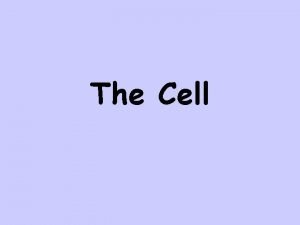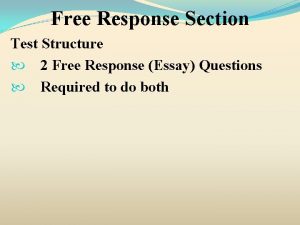Tes3 The Cell Free Response Questions Free Response











- Slides: 11

Tes#3 The Cell Free Response Questions

Free Response 25. ________________________________________ _______________ 26. a)____________________ b)____________________ c)____________________ Aim: How do organisms capture and store free energy for use in biological processes?

Must use complete sentences!!!! Don’t use bullets!! • _______ 26. a)__________________b)______________c)________________ Answer everything but Keep it simple!!! Aim: How do organisms capture and store free energy for use in biological processes?

25. Design an experiment to determine the effect of different variables on enzyme function. Include what variables you would test, and what information you can obtain from the experiments. Aim: How do organisms capture and store free energy for use in biological processes?

1. Enzyme concentration, time, p. H, and temperature could be used as independent variables in an enzyme experiment. 2. When testing one of the above variables, all others must be kept constant. 3. The control in the experiment is the reaction at standard conditions, such as at room temperature. Dependent variable will be recorded as Measurements of the appearance of the product at specific intervals. 5. The results of the experiments imply that there is a range of Optimal temperature, optimal p. H, optimal concentration, etc. 6. When the enzyme no longer functions, such as at a high temperature, denaturation of the enzyme most likely occurred.

26. The plasma membrane separates the living cell from its nonliving surroundings. (a) Describe the structure and function of the lipid bilayer which constructs cell membranes. (b) Discuss THREE modes of material transport across the cell membrane. Aim: How do organisms capture and store free energy for use in biological processes?

26. (a)(Structure)The lipid bilayer of the cell membrane consists of two layers of phospholipids arranged with their hydrophilic heads facing the water of a cell, and the hydrophobic tails isolated from water. Embedded within the lipid bilayer of the membrane are proteins and Glycoprotens/Glycolipids. (Function) The membrane is the fluid mosaic model and it is selectively permeable. It is responsible for transporting different types and sizes of molecules. Aim: How do organisms capture and store free energy for use in biological processes?

(b) Passive transport is diffusion across a membrane, and it is responsible for transporting substances down their concentration gradient. It does not require to use ATP Active transport uses ATP to transport molecules against their concentration gradients. Facilitated diffusion uses the help of a transport protein embedded in the membrane. It does not use ATP.

27. Answer the following question by using an essay format. Your response should be clearly-written, wellorganized and balanced. Diagrams may be used to supplement the discussion, but a diagram alone is insufficient. a. Compare and contrast the mechanisms of diffusion and osmosis. b. How does solute size affect the process of diffusion through a selectively permeable membrane? c. Explain what happens to an animal cell and a plant cell placed in • 1. a hypertonic solution • 2. an isotonic solution • 3. a hypotonic solution Aim: How do organisms capture and store free energy for use in biological processes?

27 a) Diffusion and Osmosis are Passive transport. They both transport substances down their concentration gradient without using ATP. However, they are different because diffusion is movement of various small substances such as gasses while Osmosis is strictly the movement of water. Aim: How do organisms capture and store free energy for use in biological processes?

b. Selectively permeable membranes only allow Small substances to diffuse. If substances are too large, they won’t be able to diffuse. c. When an animal cell is placed in a hypertonic solution, it shrives. In a hypotonic solution, an animal cell bursts. In an Isotonic solution, an animal cell keeps normal shape. When a plant cell is placed in a hypertonic solution, it is plasmolyzed (limp. ) In a hypotonic solution, it is turgid (firm. ) in an isotnonic solution a plant cell is flaccid (limp. )





















